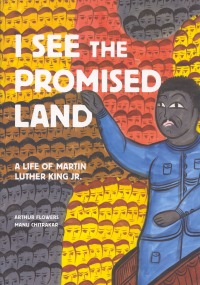| ________________
CM . . .
. Volume XIX Number 23. . . .February 15, 2013 
 |
I See the Promised Land: A Life of Martin Luther King. Jr. Rev. Ed.
Arthur Flowers. Illustrated by Manu Chitrakar.
Toronto, ON: Groundwood Books/House of Anansi Press, 2013.
154 pp., hardcover, $18.95.
ISBN 978-1-55498-328-5.
Subject Headings:
King, Martin Luther, Jr., 1929-1968-Juvenile literature.
African American Rights Workers-Biography-Juvenile literature.
African Americans-Biography-Juvenile literature.
Baptists-United States-Clergy-Biography-Juvenile literature.
African Americans-Civil Rights-History-20th century-Juvenile literature.
Grades 8-12 / Ages 13-18.
Review by Harriet Zaidman.
**** /4
|
| |
|

excerpt:
So, April 3rd, he return to Memphis. Evening before the march there is a big storm out of the Gulf and Memphis is lashed with hurricane work-thunder and lightning and stormbent trees. King, tired and dispirited, decide surely no one would show up for the big rally planned that evening at the Mason Temple. He send Abernathy in his place.
Abernathy call him from the temple.
Martin, he say,
They here Martin, they have come out into the storm to hear you.
Martin Luther King was reluctant to go to Memphis, Tennessee, in 1968. His moment in history seemed to have passed. The more radical Black Power and anti-Vietnam War movement had eclipsed his message of non-violence as the way to achieve racial equality and justice. But colleagues in Memphis urged him to come support a sanitation workers strike, and it was there, on April 3rd, 1968, that he was assassinated by James Earl Ray, a petty criminal and avowed racist.
Arthur Flowers and Manu Chitrakar illuminate King's life story, the good, the bad and the ugly, for young adults in I See the Promised Land. Recounted in the West African oral tradition of the griot – a combination of bard, storyteller, praise singer or commentator – using an African American dialect, and illustrated in the style of an Indian scroll, this book is an intriguing biography, the content of which will stick with readers who want to find out about the man whose 'I Have a Dream' speech resonates still.
The striking drawings, brightly coloured with stark black lines, depict the cruel life African-Americans, then called Negroes, lived. Pictures of enslavement, lynchings, house burnings by the Ku Klux Klan, etc., are accompanied by rectangular boxes of text with explanatory captions. The illustrations are unsettling, sometimes showing people smiling while violence reigns around them. The illustrations are also sensual and emotional, crowded with people, representing the mass movement the Civil Rights Movement was.
Flowers's text is thought-provoking, written to be read with pauses. The narrative has a beat, a rhythm, that invites it to be read aloud. Bold text intermingles with the captions, both in two-page spreads and on divided comic-book-style boxes. Flowers recounts the struggles King faced as a young man when he decided to step out of the mould his minister father and grandfather had forged for him. He moved to Montgomery, Alabama, where he emerged as a leader of the famous Bus Boycott in 1955. His words inspired a nation:
If we protest courageously, and yet with dignity and Christian love, when the history books are written in the future, somebody will have to say 'There lived a race of people, of black people, of people who had the moral courage to stand up for their rights. And thereby they injected a new meaning into the veins of history and civilization.
The years that followed were difficult, full of marches, boycotts, occupations and protests. Authorities responded with insults, water cannons, arrests, attacks with dogs and more.
Invoking the notion of 'fa' or destiny, Flowers's storyteller says King was destined for his role. He knew that he could neither rest on what had been accomplished nor give up, despite the difficulties he faced within and from outside the movement. King developed a strong public profile, but he was not a god, and Flowers reveals King's self-doubts and his frailties (including his adulteries).
Desegregation came about through much sacrifice, but, as the years passed, King's relevance was challenged, and he searched for a meaningful place in his community and society.
For some years now he has soldiered on in spite of increasing doubts. He has learned the true lesson of leadership – you always pay more than you get – real leadership always cost. Misstep don't just cost you, it cost the people who believe in you. Depending on you.
Flowers does an excellent job of including important passages of speeches. Together with the appealing illustrations and intriguing design, I See the Promised Land will teach students about the life of one of the most influential Americans of the 20th century. The griot storytelling technique will also teach them lessons about leadership and the weight of history upon those 'chosen' to lead.
Highly Recommended.
Harriet Zaidman is a teacher-librarian in Winnipeg, MB.

To comment
on this title or this review, send mail to cm@umanitoba.ca.
Copyright © the Manitoba Library Association. Reproduction for personal
use is permitted only if this copyright notice is maintained. Any
other reproduction is prohibited without permission.
NEXT REVIEW |
TABLE OF CONTENTS FOR THIS ISSUE
- February 15, 2013.
AUTHORS |
TITLES |
MEDIA REVIEWS |
PROFILES |
BACK ISSUES |
SEARCH |
CMARCHIVE |
HOME |
